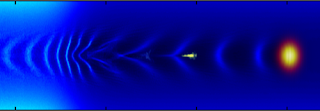 |
| Tri Alpha Energy plasma accelerator, Physics.org |
***
Time Magazine recently published an intriguing article about man's quest for clean energy in the form of fusion: Inside the Quest for Fusion, Clean Energy’s Holy Grail (subscription needed).In Lev Grossman's very readable article, he reports that startup Tri Alpha Energy is using two linear plasma accelerators pointed at each other to achieve results that larger and far more expensive tokamaks have yet to produce. Furthermore, Tri Alpha Energy will use hydrogen nuclei and boron-11, not the conventional deuterium and tritium, to fuel the reaction. Boron requires a temperature of 3 billion degrees Celsius to fuse. So far Tri Alpha has produced a ball of superheated hydrogen plasma for five milliseconds, a record in the fusion effort. Before I move on, here's Lev's description of attempting fusion:
The heat and pressure necessary are extreme. Essentially you’re trying to replicate conditions in the heart of the sun, where its colossal mass–330,000 times that of Earth–creates crushing pressure, and where the temperature is 17 million degrees Celsius. In fact, because the amounts of fuel are so much smaller, the temperature at which fusion is feasible on Earth starts at around 100 million degrees Celsius.
That’s the first problem. The second problem is that your fuel is in the form of a plasma, and plasma, as mentioned above, is weird. It’s a fourth state of matter, neither liquid nor solid nor gas. When you torture plasma with temperatures and pressures like these, it becomes wildly unstable and writhes like a cat in a sack. So not only do you have to confine and control it, and heat it and squeeze it; you have to do all that without touching it, because at 100 million degrees, this is a cat that will instantly vaporize solid matter.News (with a skeptical tone) of Tri Alpha's recent milestone was published by Physics.org in Tri Alpha Energy reportedly makes important breakthrough in developing fusion reactor. It's important to note that the physics community has a lot of tokamaks and funding to defend. Here's the link to Tri Alpha Energy's website.
For information on plasma acceleration, take a look at Oxford University's page on plasma accelerators. Note that a laser beam qualifies as a particle beam. Overturned scientific explanation may be good news for nuclear fusion (2011) talks about new information on the hydrogen-boron reaction.
***
 |
| Electron injection ramp, Oxford University-Physics Dept. |
***
-- Marge

No comments:
Post a Comment